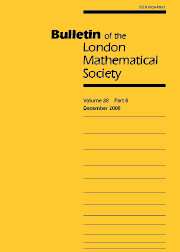Article contents
ON FUCHSIAN GROUPS WITH THE SAME SET OF AXES
Published online by Cambridge University Press: 01 September 1998
Abstract
Let Γ be a Fuchsian group. We denote by ax(Γ) the set of axes of hyperbolic elements of Γ. Define Fuchsian groups Γ1 and Γ2 to be isoaxial if ax(Γ1)=ax(Γ2). The main result in this note is to show (see Section 2 for definitions) the following.
Theorem 1.1. Let Γ1and Γ2be isoaxial arithmetic Fuchsian groups. Then Γ1 and Γ2 are commensurable.
This result was motivated by the results in [6], where it is shown that if Γ1 and Γ2 are finitely generated non-elementary Fuchsian groups having the same non-empty set of simple axes, then Γ1 and Γ2 are commensurable. The general question of isoaxial was left open. Theorem 1.1 is therefore a partial answer. Arithmetic Fuchsian groups are a very special subclass of Fuchsian groups (for example, there are at most finitely many conjugacy classes of such groups of a fixed signature), and the general case at present seems much harder to resolve.
The technical result of this paper which implies Theorem 1.1 is Theorem 2.4 (below), proved in Section 4. Denoting the commensurability subgroup by Comm(Γ) and the subgroup of PGL(2, R) which preserves the set ax(Γ) by Σ(Γ) (careful definitions are given below), we have the following theorem which describes the commensurability subgroup of an arithmetic Fuchsian group geometrically.
Theorem 2.4. Let Γ be an arithmetic Fuchsian group. Then Comm(Γ)=Σ(Γ).
The problem of ‘isoaxial implies commensurable’ is like a dual problem to ‘isospectral implies commensurable’. It was shown in [8] that this latter statement holds for arithmetic Fuchsian groups. As in the case considered here, the general statement about isospectrality implying commensurability is still open.
Information
- Type
- Notes and Papers
- Information
- Copyright
- © The London Mathematical Society 1998
- 5
- Cited by

